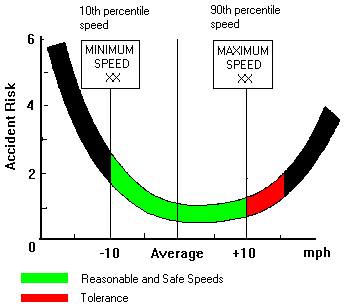US Department of Transportation
Federal Highway Administration
FHwA contact: Davey L. Warren, HSR-30, FTS 285-2426
This study reviewed the principles and practices used to set speed limits. It is based mainly on a survey of traffic officials conducted by the American Association of State Highway and Transportation Officials (AASHTO) Subcommittee on Traffic Engineering. All States and 44 city and county agencies responded to this survey.
The main factors used in setting speed limits are shown below. The most commonly reported lower level of the speed limit is 5 mph below the 85th percentile with 10 mph below being the extreme.
Main Factors Used to Set Speed Limits
Factor Percent of states/locals ----------------------------------------- 85th percentile speed 100/86 Roadside development 85/77 Accident experience 79/81 10 mph pace 67/34 Roadway geometrics 67/57 Average test run speed 52/34 Pedestrian volumes 40/50
 Based on the best available evidence, the speed limit should be set at
the speed driven by 85 to 90 percent of the free-moving vehicles
rounded up to the next 5 mph increment. This method results in speed
limits that are not only acceptable to a large majority of motorists,
but also fall within the speed range where accident risk is lowest.
Allowing a 5 mph tolerance, enforcement would be targeted at drivers
who are clearly at risk.
Based on the best available evidence, the speed limit should be set at
the speed driven by 85 to 90 percent of the free-moving vehicles
rounded up to the next 5 mph increment. This method results in speed
limits that are not only acceptable to a large majority of motorists,
but also fall within the speed range where accident risk is lowest.
Allowing a 5 mph tolerance, enforcement would be targeted at drivers
who are clearly at risk.
No other factors need to be considered since they are reflected in the
drivers' speed choice. If there are unusual hazards not readily
apparent to drivers, then a warning sign could be installed giving the
nature of the hazard and, if necessary, supplemented with a realistic
advisory speed.